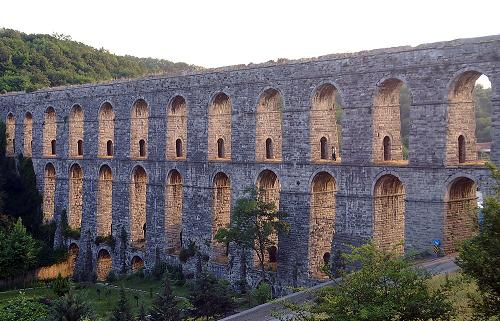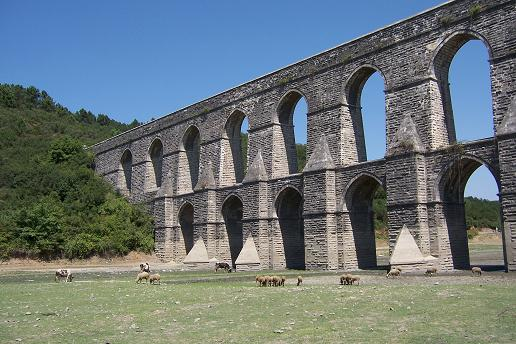
|
|




Excursion Route 6 - Aqueducts
Paşadere Aqueduct, Kovuk (Eğri) Aqueduct, Uzun Aqueduct, Güzelce Aqueduct, Mağlova Aqueduct
You are about to try perhaps the most challenging, yet the most adventurous, of the excursion routes that take you to the architectural works of Sinan. If you wish to see all of the aqueducts, you may need a 4 by 4 drive or a vehicle with a high frame. On a shorter trip that we recommend, you will be able to see four of the more significant aqueducts that belong to the Kırkçeşme Water Works, which were all built by Sinan, with the order of Sultan Kanuni Süleyman, in nine years. These are not all of the aqueducts in the water system, yet they are the more impressive ones.
Follow the lush, green road that leads from Sarıyer Bahçeköy towards Kemerburgaz. The first aqueduct you will see that is Sinans work, is the Pashadere Kemeri (Pashadere Aqueduct). If you have set upon this journey during summer months, you will be able to view only a small portion of this structure through the greenery. Passing underneath the aqueduct, the road will take you to the center of Kemerburgaz. Driving on the asphalt road from Kemerburgaz, you can easily reach two other aqueducts: Uzun Aqueduct and Kovuk (Bent) Kemer. You can find the Kovuk Kemer by taking a left turn from central Kemerburgaz. It is on the Kemerburgaz-Hasdal road.
Kovuk Aqueduct
One end of the aqueduct has been covered over by a factory that belongs to the Municipality and at the other end, there are beehives. You can climb the aqueduct and view the structure where it makes an almost ninety degree turn. The bold but old and fatigued walls of the old aqueduct have been retired and water is now carried over to Istanbul by pipes laid down according to new technologies.
From this point, you should return on the same road in the direction of your starting point to see the Uzun Aqueduct (Long Aqueduct). Continue for about 2 km more towards the town of Göktürk. When you catch the first glimpse of the next aqueduct, you will understand the reason for its name.
Güzelce Aqueduct.
Exit to TEM from the Kemerburgaz-Hasdal road, then take the Alibeyköy exit and drive towards Gazi Neighborhood. Within a short while, you will drive through uneven dirt roads to two more 16th century aqueducts built by Sinan which are perhaps the most significant ones among structures that deal with water systems.
,
We may start with the more modest of the two. This is the Güzelce (also called Gözlüce or Cebeciköy) Aqueduct, one of the most significant aqueducts in the Kırkçeşme Water Works System. The structure now remains in the Alibeyköy Dam Lake. There are two different routes that take us to the aqueduct, one leading to its east, the other to its west side. The one that passes through Cebeci village is better than the one that goes through Gazi Neighborhood. If you have time, try both of these routes to have a full view and perception of the aqueduct from different angles.
If you have chosen the Cebeci road, trace your route back to the village center, pass by the stone quarry that is beyond the village, and go down to the lake bank across the valley. The villagers who live here are well familiar with these surroundings. In case you feel that you may be lost, you can easily get instructions from the people who live in Cebeci village. Going past the stone quarry and upon reaching the bank of the dam lake, you will not be able to see the Mağlova Aqueduct, immediately. As you walk for about 200 m under the high-tension wires, following the valley on the right hand side, this grandiose structure will appear before you. The forest road that starts at Kemerburgaz can also take you to Mağlova. This alluring aqueduct, that has been baffling people throughout the ages with its aesthetic charm, still continues to carry its water to Istanbul, just as back in the 16th century.
| © 2006 Respect to Sinan. All rights reserved. | [Çekül Foundation] [Union of Historical Towns] |
